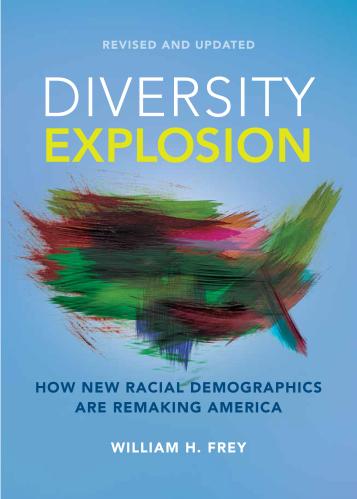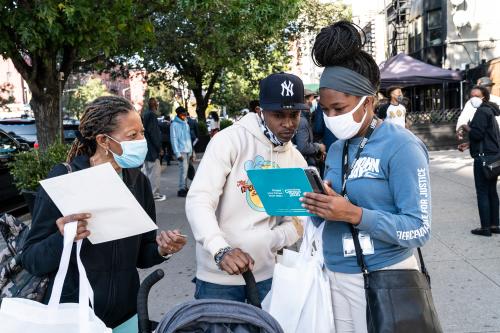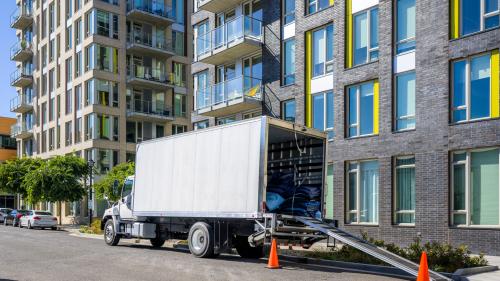Recently released U.S. Census Bureau population estimates emphasize that it was domestic out-migration that exerted an outsized demographic impact on large metropolitan areas during the prime 12 months of the COVID-19 pandemic. These estimates—for the period July 1, 2020 to July 1, 2021—reveal an absolute decline in the aggregate size of the nation’s 56 major metropolitan areas (those with populations exceeding 1 million). At the same time, smaller metro areas, as a group, experienced higher population growth than in each of the previous two years, while non-metropolitan America showed the greatest annual population gain in more than a decade.
These shifts occurred during a year in which the nation registered its lowest population growth (0.1%) in at least 120 years, due to sharply reduced immigration from abroad and much lower levels of natural increase (the excess of births over deaths). Because those demographic components affected most parts of the nation, migration within the U.S. was most instrumental in accentuating or softening the impact of slower national growth in particular areas. The new data shows that, much more than in the first pandemic year, domestic migration led to greater losses or reduced gains in most of the nation’s biggest metro areas, as well as their core urban counties.
The analysis below examines annual population changes for major metro areas and core urban counties over the 2010-2021 period based on the latest census population estimates.(i) It provides an assessment of how each demographic component—domestic migration, international migration, and natural increase—impacted area population change up to and through the most recent pandemic year.
The results show that each of these demographic components continued and often exacerbated trends that were already evident before the pandemic. Most importantly, they emphasize the outsized role of domestic migration in dispersing population to smaller-sized places in the prime pandemic period of 2020 to 2021.
A national growth context of lower immigration and natural increase
Before examining metropolitan growth and within-U.S. migration, it is important to understand the national growth context–that is, the demographic components of national growth—immigration and natural increase—have driven U.S. population growth to a historic low in the past year. (Download Table A)
 Immigration began to lower appreciably after 2017 due to restrictive immigration measures enacted during the Trump administration. Declines in natural increase during the 2010s reflected more deaths associated with an aging population as well as the after-effects of the 2007-09 Great Recession, which saw a postponement in childbearing for young adult women. Both immigration and natural increase contributions to population growth declined markedly in 2020-21, in large part due to the pandemic—though these pandemic impacts were already partially evident in 2019-20 data.
Immigration began to lower appreciably after 2017 due to restrictive immigration measures enacted during the Trump administration. Declines in natural increase during the 2010s reflected more deaths associated with an aging population as well as the after-effects of the 2007-09 Great Recession, which saw a postponement in childbearing for young adult women. Both immigration and natural increase contributions to population growth declined markedly in 2020-21, in large part due to the pandemic—though these pandemic impacts were already partially evident in 2019-20 data.
Although net international migration and natural increase each added more than 1 million people to the population annually at mid-decade, their contributions in 2020-21 dipped to just 244,622 and 148,043 people, respectively. Both slowdowns were evident in all parts of the country, especially the decline in natural increase. The new census estimates showed that over two-thirds of U.S. counties registered a natural decrease (more deaths than births) between 2020 and 2021.
As a group, major metro areas saw an absolute population loss during the pandemic
The abrupt growth slowdown in major metropolitan areas follows a decade in which they experienced uneven population shifts. Many of these areas showed healthy growth levels in the early 2010s, only to start dropping after the middle of the decade. That early-decade growth reflected the aftermath of the Great Recession and housing crash, which left many potential movers—especially young adult millennials—unable to obtain jobs and housing elsewhere. During that period, large metro areas and their core cities grew more rapidly than smaller metro and non-metropolitan areas. The picture changed after mid-decade, as the economy picked up and brought greater population shifts to to smaller-sized areas as well as suburban portions of major metro areas.
 The onset of the pandemic-accelerated growth slowdown in major metro areas led to an absolute population loss in 2020-21 among those areas combined. This is the first time the nation’s major metro areas registered an annual negative growth rate since at least 1990. At the same, the growth rate of smaller metropolitan areas ticked upward, while non-metropolitan counties as a whole saw their highest annual growth rate in over a decade.
The onset of the pandemic-accelerated growth slowdown in major metro areas led to an absolute population loss in 2020-21 among those areas combined. This is the first time the nation’s major metro areas registered an annual negative growth rate since at least 1990. At the same, the growth rate of smaller metropolitan areas ticked upward, while non-metropolitan counties as a whole saw their highest annual growth rate in over a decade.
A closer look at the nation’s 56 major metro areas shows different patterns of growth and decline. Still, among these, 50 registered either slower growth, greater declines, or a switch from growth to decline between 2019-20 and 2020-21. Among the latter are Boston, Miami, Washington, D.C., Seattle, Minneapolis-Saint Paul, and Philadelphia. Moreover, 42 major metro areas registered their lowest growth or greatest decline in any year since 2010. (Download Table B)
Fully 26 of these major metro areas experienced population losses in 2020-21, compared with 15 in 2019-20 and just two in 2010-11. Metro areas with population losses are mostly located in coastal areas, the industrial Midwest, and parts of the South. Those with the greatest numeric losses are New York (-327,955), Los Angeles (-175,913), San Francisco (-116,385), and Chicago (-91,671). Each saw substantially larger losses than the previous year. (Download Table C)
The major metro areas with greatest gains in 2020-21 tend to be located in the Sun Belt, especially Texas, Florida, Arizona, North Carolina, and Georgia. Leading the list are Dallas (+97,290), Phoenix (+78,220), Houston (+69,094), and Austin, Texas (+53,301). Each of these grew less than in each of the previous two years. One notable exception to these trends is Riverside, Calif., which registered a growth uptick in 2020-21, likely due to it being a destination for movers leaving Los Angeles and other coastal California metros areas.
Domestic migration is the primary driver of demographic change
The prominence of domestic migration as the driver of demographic change in the prime pandemic year is depicted in Figure 3, which examines the trends in demographic components—domestic migration, international migration, and natural increase—for different metro area and non-metropolitan categories.
 As discussed earlier, most parts of the country experienced downturns in immigration and natural increase both prior to and especially during the past two pandemic years. This was the case for major metro areas, other metro areas, and non-metropolitan areas—the latter registering a rise in natural decrease during the pandemic.
As discussed earlier, most parts of the country experienced downturns in immigration and natural increase both prior to and especially during the past two pandemic years. This was the case for major metro areas, other metro areas, and non-metropolitan areas—the latter registering a rise in natural decrease during the pandemic.
What distinguishes these areas particularly in 2020-21 is how domestic migration has affected them. Since 2010, major metro areas, as a group, shifted from net in-migration through 2014 to out-migration as, in an improving economy, more residents relocated to other parts of the country. Even during the pandemic’s first year, major metro area out-migration did not change much from previous years. But in 2020-21, the rate of out-migration more than tripled. While immigration and natural increase continued to shift downward in major metro areas, the sharp rise in domestic out-migration was the major cause of these areas’ overall population loss. This is especially notable in New York and Los Angeles (see Figure 4).
 In contrast, domestic migration rose especially sharply for smaller metro and non-metropolitan areas, countering their continued downturns in immigration and natural increase. The rise in domestic in-migration was particularly notable for non-metropolitan areas, which experienced annual migration losses during the decade’s earlier years.
In contrast, domestic migration rose especially sharply for smaller metro and non-metropolitan areas, countering their continued downturns in immigration and natural increase. The rise in domestic in-migration was particularly notable for non-metropolitan areas, which experienced annual migration losses during the decade’s earlier years.
A downward migration shift was apparent in most of the 56 major metro areas (Download Table D). Thirty-one experienced domestic out-migration in 2020-21, and 35 showed either greater net out-migration or smaller net in-migration than in 2019-20. Among several major metro areas that experienced domestic in-migration in 2020-21 (such as Phoenix, Dallas, Austin, Charlotte, N.C., and Atlanta), those migration levels were smaller than in in 2019-20.
While domestic out-migration was a primary factor in the growth slowdowns in most major metro areas, lower immigration and lower natural increase also contributed. In 2020-21, net international migration was lower than in 2019-20 for 55 of the 56 metro areas, and natural increase was smaller in each of them. In fact, 10 of these metro areas registered natural decreases in their populations, led by Pittsburgh, Tampa, Fla., St. Petersburg, Fla., Cleveland, and Detroit. (Download Table D)
Urban core counties experienced dramatic population declines
The pandemic year of 2020-21 showed substantial declines in highly dense urban core counties within major metro areas, driven heavily by domestic out-migration. Still, it is useful to see this in the context of urban core county growth over the previous decade. Just as major metro areas sustained uncommonly high growth levels in the early 2010s, so too did many of their core counties and cities, partly reflecting “stuck in place” residential patterns of young adults, before they moved outward in mid-decade.

 Figure 5 displays annual growth patterns for urban core counties and suburban counties within major metro areas.(ii) Urban core county growth for these aggregated counties began dropping noticeably after 2016-17, and registered absolute population decline in 2019-20. This population decline accelerated to negative 1% over the prime pandemic year of 2020-21. As Figure 6 shows, most of this decline is due to accentuated out-migration, with reduced immigration from abroad and reduced natural increase contributing much more modestly to this shift.
Figure 5 displays annual growth patterns for urban core counties and suburban counties within major metro areas.(ii) Urban core county growth for these aggregated counties began dropping noticeably after 2016-17, and registered absolute population decline in 2019-20. This population decline accelerated to negative 1% over the prime pandemic year of 2020-21. As Figure 6 shows, most of this decline is due to accentuated out-migration, with reduced immigration from abroad and reduced natural increase contributing much more modestly to this shift.
The combination of domestic migration, immigration, and natural increase led to a different outcome in the suburban counties of major metro areas. There, domestic migration increased through mid-decade to a fairly constant level from 2015 to 2019. It rose after that, especially dramatically during the prime pandemic year of 2020-21, in large part due to an increase in city-suburb movement.
Yet despite this domestic migration spurt, smaller metro areas, as a group, grew more slowly during the pandemic than in the immediately preceding years. This occurred because of marked declines in both immigration and natural increase. So despite the opposite 2020-21 migration patterns between urban core and suburban counties, the former experienced remarkable declines in their population growth while the growth rate of the latter was less than in earlier years.
Two urban core counties that exhibit especially strong domestic-migration-driven population declines are Manhattan (New York County) and San Francisco County, which is contiguous with the city of San Francisco. Both counties are symbolic of dense core areas, home to large numbers of young people and professionals, and dependent on public transportation—attributes which have been associated with pandemic-related flight. Although each of these counties experienced increased out-migration and population declines during the first pandemic year, these became far more accentuated in 2020-21.
Among 48 urban core counties in major metro areas, most experienced declines in growth already in 2019-20. In 2020-21, 42 of the 48 showed even lower population growth or increased decline. All but one of those counites saw lower growth than in any year during the 2010s, with domestic out-migration being a primary component (Download Table E and Download Table F) Aside from Manhattan and San Francisco, urban core counties that registered the greatest 2020-21 rates of population loss were: Kings (Brooklyn), Queens, and Bronx counties in New York; Suffolk County, Mass. (home to Boston); Washington, D.C.; St Louis County, Mo.; Santa Clara County, Calif.; Alameda, County, Calif.; Cook County, Ill. (home to Chicago); New Orleans Parish, La.; Los Angeles County; Philadelphia County; and Ramsay County, Minn. (home to Saint Paul).
Are these population shifts just a one-year blip?
The demographic shifts revealed by the latest census population estimates are not just a continuation of past trends. The sharp domestic out-migration from the nation’s major metro areas and urban core counties in the 2020-21 pandemic year was unusually large, even when compared with the previous year and the modest growth declines in the last half of the 2010s. As a result of out-migration from these areas, many smaller metro areas and rural counties experienced higher growth than in previous years.
The reason for this migration and the pandemic’s impact on it is highly debated. Is it a result of Covid-related health concerns associated with living in highly dense areas? Or, relatedly, is it a result of individuals’ greater ability to work from home?
If so, then the continuing downturn in COVID-19 transmission may alleviate these fears and motivations, especially as large urban areas revive their economies and infrastructure to bring a return of in-person work. Analyses of monthly movement from U.S. Postal Service records and other sources hint that some return movement may already be occurring. Surely, the extremely high levels of out-migration could be tempered, and return to the more modest levels of suburb and small area movement observed in the years just prior to the pandemic.
On other hand, there is the possibility that some post-pandemic living and working trends may become more commonplace. Much will depend on new generations of young movers: late millennials and Gen Z. Will they follow the patterns of earlier younger movers, who embraced city lifestyles and amenities, at least during their early work and pre-family-building years? Or will the pandemic period make them more likely to see suburban and small-town life more attractive? Of course, much will also depend on the preferences of employers, housing construction, and the likelihood of continued hybrid work opportunities.
And while domestic out-migration was the primary engine of recent population shifts in major metro areas, the impact of lower immigration and natural increase cannot be ignored. Both prior to and during the pandemic, the nation’s immigration was constrained to some of the lowest levels in decades. As the economy recovers, there will certainly be pressures to increase levels of international migrants to revive national population growth, especially among the younger labor force population. If past trends re-emerge, this will especially benefit the population growth of major metro areas.
Similarly, the extreme downturn in natural increase—due to both more deaths and fewer births—will likely also reverse and contribute to further growth in all parts of the country, including large metro areas.
Nonetheless, the new census estimates make plain that the pandemic exerted a negative impact on America’s population growth, especially in its biggest metro areas and urban cores. It remains to be seen how deeply this impact will be felt as the nation adapts to what hopefully will be a return to normal.
i. This data is compiled by the Census Bureau’s population estimates program: evaluation estimates for the period 2010-2020 and vintage 2021 estimates for 2020-2021.
ii. Urban core areas are defined as counties with more than 95% of their population residing in urbanized areas, based on a typology developed by Brookings Metro.







Commentary
New census data shows a huge spike in movement out of big metro areas during the pandemic
April 14, 2022